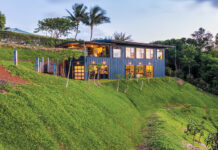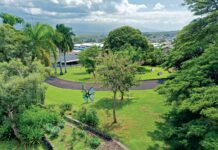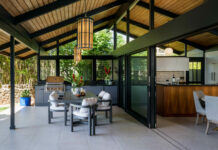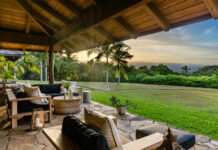Story by Sky Barnhart | Photography by Tony Novak-Clifford
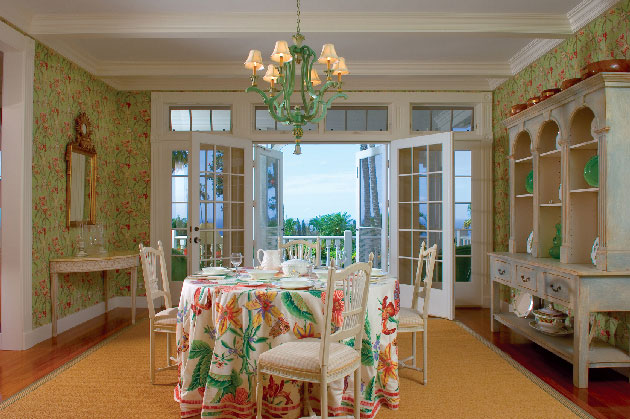 The first thing you notice is the fence. Not a stern, closed-up kind of fence, but a generous white split-rail rambling along the roadside, offering tantalizing glimpses of smooth green lawns, majestic old shade trees, and a pretty white gazebo where lemonade might be served on a hot summer’s day, perhaps after a tennis match on the well-kept courts glimpsed farther back in the property. . . .
The first thing you notice is the fence. Not a stern, closed-up kind of fence, but a generous white split-rail rambling along the roadside, offering tantalizing glimpses of smooth green lawns, majestic old shade trees, and a pretty white gazebo where lemonade might be served on a hot summer’s day, perhaps after a tennis match on the well-kept courts glimpsed farther back in the property. . . .
These are the kinds of daydreams my mind happily entertains when I drive past the historic Baldwin Estate on Ha‘iku Road. Passing the stately driveway at the corner, I imagine turning in through the tall white gates and following the lamppost-lined drive to where the house sits on a splendid rise.
Except today, I’m actually doing it. My tires crunch on the gravel as I pull up under the porte-cochere. Behind me, the sounds of the busy, modern world fade away, replaced by birdsong and the serene rustle of trees.
Stepping onto the front porch, I’m expecting a heavy knocker in the shape of a lion’s head, perhaps answered by a butler in starched waistcoat—but the reality is a simple buzzer met by the housekeeper, a young woman dressed in running shorts.
Inside the entry hall, a staircase with a gleaming wood banister leads to upper regions, and to my left, sunlight streams through lemon-yellow curtains into the living room. To my right is the library, a cozy room with fireplace and floor-to-ceiling bookshelves. Although I’d love to curl up and read an Agatha Christie, the housekeeper is leading me through the library to the screened lanai.
The airy room is peaceful and cool, furnished with pale-green wicker sofas with soft tangerine cushions. Scrapbooks stacked on the low table are pasted with historic newspaper clippings and before-and-after photos of the house’s renovations.
My guide sets out a wooden tray with a pitcher of ice water, glasses and flowered cloth napkins. I later learn that her mother was the housekeeper here at the property they call “Ha‘iku House” many decades ago. Now the daughter works for the new owners, the Simon family. “Feel free to look around while you wait for Bill,” she says. “But don’t get lost!”
I pad barefoot down a long, hardwood-floored hallway. Six bedrooms open off the hall, one after the other, each with its own bath. The rooms are painted in pastel hues that accent the white moldings and thick, cream-colored carpets.
Simon family photos adorn the shelves, and a signed photo of the Nixon family hangs on one wall, evidence of the Honorable William E. Simon Sr.’s service as sixty-third secretary of the U.S. Treasury under President Richard Nixon, and later President Gerald Ford. Over the years, famous guests like Newt Gingrich have slept within these walls.
At the end of each room, sliding glass doors open onto the grounds, where a charming cottage is visible beneath the spreading trees. The one-bedroom, one-bath dwelling (now a guest cottage) was built for the manager of the island’s first sugarcane company, Ha‘iku Sugar, in 1857. The mill was located across the road.
The main house was built in the 1880s as the family home of Henry P. Baldwin, who, together with Samuel Alexander, established one of the “Big Five” companies of Hawai‘i industry, Alexander & Baldwin, Inc.
Henry’s son, Dr. William Baldwin, is responsible for the estate’s amazing collection of trees. His passion for travel and trees of all kinds resulted in hundreds of tropicals, subtropicals and palms from all over the world, some that are now almost 150 years old.
The huge trees stand so close to the house that one—a royal poinciana—recently fell on the back bedroom, necessitating extensive repair work, property manager Bill Hoskinson later tells me. Maintaining the forty-acre property is a full-time job for the three staff members who live onsite in former plantation cottages.
I continue my tour through the quiet house, enjoying a quality of softness often missing in today’s luxury homes. Los Angeles-based interior designer Janet Louise Lohman employed deep carpets, polished wood, latticework and floral accents to create a sense of graciousness and peace.
Turns out that Old World feeling is part of a careful preservation plan.
Fresh from a surf session at Ho‘okipa Beach Park and a quick trip to the backyard sauna, owner Bill Simon joins me with coffee cup in hand, eager to share his family’s appreciation for the estate.
“We know this is an important historic property in the Islands, and we want to be good custodians,” he says. “You can feel the generations of Baldwins that lived here: the son, the grandson, the great grandson—it’s a chain of life. . . . We’re bringing it into the twenty-first century while retaining the history, which we respect.”
Since Simon bought the estate with his father twenty years ago, their renovations have taken advantage of the home’s sweeping vistas in unobtrusive ways—wrapping the lanai around the makai (ocean) side of house and adding an upstairs master suite looking out to the ocean view. The additions by architect Hans Riecke are so well executed that you would swear it had always been like this.
Simon gives me a tour of the upper level, leading me up stairs that creak satisfyingly with every step. Beneath vaulted ceilings, the master suite has romantic, old-fashioned features like a big white four-poster bed, balanced by modern amenities like the glass-and-tile shower and sunken tub.
Huge black-and-white photos of Simon’s parents on their wedding day adorn the wall above the stairs. Family is very important to Simon, who is one of seven siblings. He and his wife, Cindy, have four children, and they share the estate with his sister Julie and her two youngsters, making a full house and “a lot of memories,” Simon says.
These grounds are small-kid heaven. While visiting the estate from their home in California, the keiki used to play hide-and-seek in the roots of the giant Indian laurel tree, romp with the goats and sheep in the back pasture, play tennis and croquet, and swim in the ocean-view pool.
Over the years, Simon has enhanced the home’s historical feel by commissioning traditional furniture like that produced in Hawai‘i in the 1800s. Pieces by Maui master craftsman Peter Naramore include an exquisite game table with inlaid backgammon and chess boards that graces the lanai, and a koa-veneer “canoe table” that was designed to complement an original Norman Rockwell painting in the entry hall.
After a peek at the elegant dining room and spacious, gleaming kitchen, we step out the back door to a waiting golf cart. Simon takes me for a spin around the grounds, driving the cart barefoot past citrus orchards and palm groves. He points out the wooden framework of an outdoor cathedral built by previous owner televangelist Robert Schuller, who occasionally filmed his “Hour of Power” TV show on the grounds.
As we cruise through a fenced pasture, shaggy goats and sheep surround the cart with friendly bleats, and two llamas survey us disdainfully. Simon is like a kid, hopping off the cart to get closer to the animals.
“Isn’t this great?” he asks, seemingly unaware of the fact he needs to be at the airport in thirty minutes to fly back to Los Angeles. He’s a busy, important man—in fact, he ran for governor of California in 2002, and is considering a run for lieutenant governor in 2010.
But here at Ha‘iku House, he’s relaxed and happy, enjoying the surf, the sun, and his family’s link in the chain of island history.

